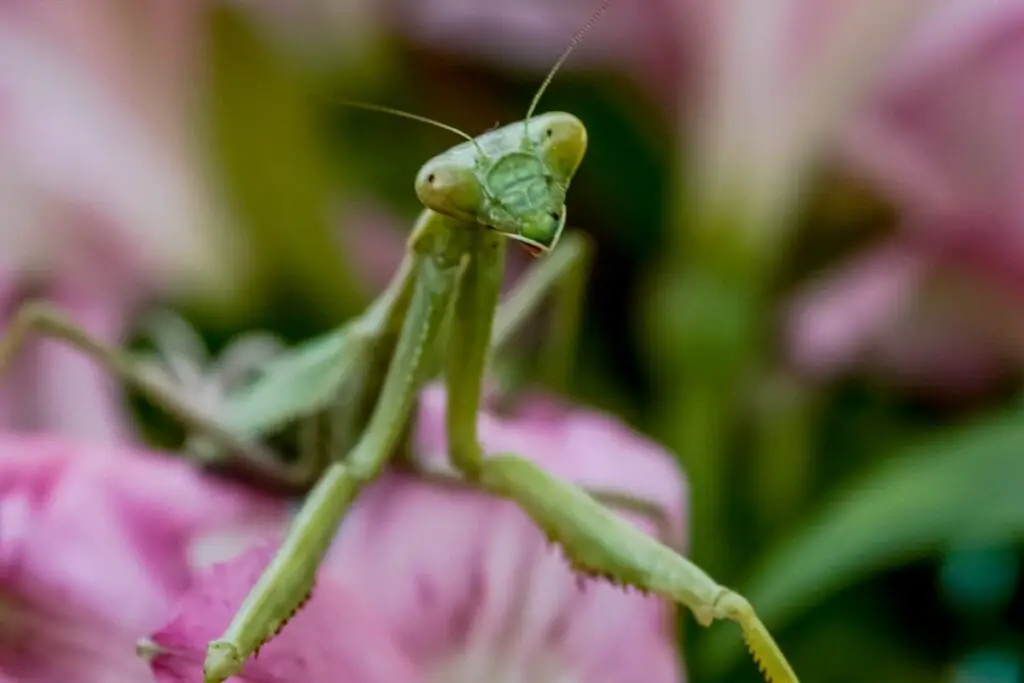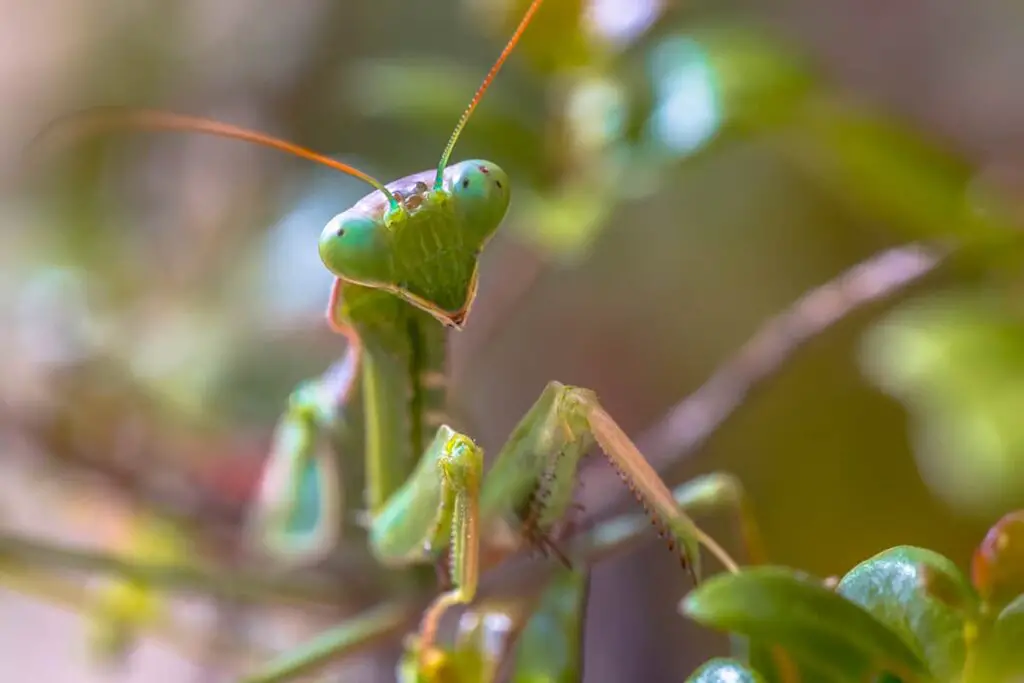Caring for a sick praying mantis can be a delicate task requiring close attention and an understanding of their needs. Recognizing when your mantis is unwell is crucial, and simple signs such as a lack of appetite or decreased activity can indicate that your insect friend is experiencing health issues. Providing a safe, comfortable environment for recuperation is key in aiding their recovery.
When addressing the health of a praying mantis, it’s important to consider their habitat, diet, and possible external factors that could contribute to their illness. Creating a habitat that simulates a praying mantis’s natural environment, ensuring the mantis has access to a variety of appropriate insects to eat, and keeping the enclosure clean and at the right humidity and temperature levels are essential steps. If symptoms persist, seeking advice from a veterinarian specializing in exotic pets or an experienced mantis caregiver can offer further guidance on how to nurse your mantis back to health.
Understanding Mantis Health
Keeping your praying mantis healthy is central to ensuring its longevity and happiness. Get to know the signs of a robust mantis and recognize the symptoms of possible illnesses to provide the best care.
Signs of a Healthy Mantis
Appearance and Behavior:
- Bright, clear eyes
- Responsive movements
- Firm, intact exoskeleton
- Regular feeding and drinking behavior
- Healthy molting process (proper shedding of its exoskeleton)
Environmental Factors:
- Clean habitat with appropriate temperature and humidity
- Ample space for movement
- Presence of plants or branches for climbing
Recognizing Illness Symptoms
Physical Signs:
- Lethargy or reduced movement
- Lack of appetite
- Discoloration or spots on exoskeleton
- Difficulty molting
- Visible wounds or abnormalities
Behavioral Changes:
- Unusual posture or swaying
- Repeated rubbing of body parts
- Excessive secretion of fluids
To learn more about specific conditions that may affect your praying mantis, including fungal and bacterial infections, you can refer to in-depth resources on mantises’ health. Moreover, a comprehensive guide on mantis care can provide you with additional insights into their unique needs and behaviors.
Caring for a Sick Mantis
When your praying mantis falls ill, creating a restorative environment and providing proper nutrition are your top priorities. Quick intervention with common treatments may enhance recovery.
Creating a Healing Environment
Habitat: Ensure your mantis has a stress-free zone to recuperate by giving it a quiet and clean enclosure. The cage should be at least three times the length of the mantis and twice the width, ensuring ample space for recovery.
Temperature and Humidity: Maintain a consistent temperature and humidity within the recommended ranges for your species of mantis. A slight increase may help boost the immune system, but be careful not to stress your mantis with too much heat.
Nutrition and Hydration
Feeding: Offer your sick mantis easy-to-catch, protein-rich prey that is smaller than usual, to ensure that eating is not strenuous. Look for signs of a good appetite, as it’s a positive indicator of health.
Hydration: Adequate water is crucial. Provide droplets on the enclosure walls or on vegetation for your mantis to drink. This can be achieved by misting the enclosure lightly, but always avoid making it too damp.
Common Treatments
Isolation: If you have multiple insects, isolate the sick mantis to prevent the spread of potential diseases.
Injury Care: For minor injuries, a clean environment and minimal handling will support natural healing processes. For more severe cases, you may need to consult an entomologist or a vet experienced with insects.
Preventing Health Issues
To ensure your praying mantis stays healthy, focus on creating an ideal living environment and minimizing stress.
Proper Habitat Maintenance
Your praying mantis requires a clean and well-ventilated enclosure. Here’s a brief guide to maintaining the habitat:
- Ventilation: Airflow is crucial to prevent mold and fungal infections. Ensure your mantis habitat has a secure, screened lid for proper airflow.
- Moisture Control: The substrate should be moisture-absorbing to maintain humidity, yet avoid being overly wet. Use sterilized soil free of pesticides and fertilizers.
- Cleanliness: Regularly remove waste and uneaten food. Clean the tank at least weekly, being more frequent if the mantis is injured as noted on Pets on Mom.com.
Stress Reduction Strategies
Reducing stress is key to preventing health issues in praying mantises. Consider these strategies:
- Adequate Space: Your enclosure should be at least three times the length of the mantis and twice the width.
- Quiet Environment: Keep the habitat in a low-traffic area to reduce disturbance.
- Proper Handling: When necessary, handle your mantis gently to avoid injuring its delicate body.
Frequently Asked Questions
Caring for a sick praying mantis requires attentive observation and appropriate action. The following FAQs provide targeted advice for recognizing and treating illnesses in these fascinating insects.
How can you tell if a praying mantis is sick?
A sick praying mantis may exhibit symptoms like refusal to eat, lethargy, or dark spots on its body. A healthy mantis is usually quite active, so any changes in behavior are worth noting.
What should you feed a weak praying mantis?
Offer easily digestible foods like small, soft-bodied insects to a weak praying mantis. Avoid larger or harder prey that may require more effort to capture and consume.
What are common diseases in praying mantises?
Praying mantises can suffer from conditions related to mismolting, as well as fungal and bacterial infections. Limb loss and general frailty could occur with age or due to injuries.
How do you treat a praying mantis with a fungal infection?
For a fungal infection, isolating your mantis and maintaining a clean habitat with moderate humidity is crucial. Consult with a vet for appropriate antifungal treatments.
What steps can you take to nurse a sick praying mantis back to health?
Ensure a warm environment and offer small portions of food to conserve the mantis’s energy. Keep their habitat clean to prevent further stress and infections.
How do you rehydrate a dehydrated praying mantis?
Gently mist the mantis’s enclosure to provide a source of water, ensuring the environment is not overly humid. You can also provide water droplets on mesh or foliage for them to drink directly.
Driven by a passion for those tiny creatures that rule our world, we at Bug Domain strive to be your go-to resource for information on insects.




